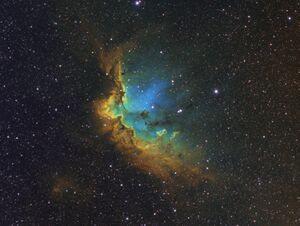Astronomy:DH Cephei
| Observation data Equinox J2000.0]] (ICRS) | |
|---|---|
| Constellation | Cepheus |
| Right ascension | 22h 46m 54.111s[2] |
| Declination | +58° 05′ 03.53″[2] |
| Apparent magnitude (V) | 8.61[3] (8.63 – 8.70)[4] |
| Characteristics | |
| Evolutionary stage | Main sequence |
| Spectral type | O5.5 V + O6 V[5] |
| B−V color index | 0.334±0.041[6] |
| Variable type | Ellipsoidal[7][4] |
| Astrometry | |
| Radial velocity (Rv) | −33.4±3.2[6] km/s |
| Proper motion (μ) | RA: −2.599[2] mas/yr Dec.: −2.236[2] mas/yr |
| Parallax (π) | 0.3397 ± 0.0138[2] mas |
| Distance | 9,600 ± 400 ly (2,900 ± 100 pc) |
| Absolute magnitude (MV) | −4.66±0.25 (A) −4.55±0.25 (B)[8] |
| Orbit[3] | |
| Period (P) | 2.11095 d |
| Semi-major axis (a) | ≥9.79±0.17 R☉ |
| Eccentricity (e) | 0.0 (fixed) |
| Periastron epoch (T) | 2,456,525.564±0.006 HJD |
| Details[3] | |
| A | |
| Mass | 25.0[9] or 38.4±2.5 M☉ |
| Radius | 8.31[9] R☉ |
| Luminosity | 2.34×105[9] L☉ |
| Surface gravity (log g) | 4.3±0.3 cgs |
| Temperature | 44,000 K |
| Rotational velocity (v sin i) | 175 km/s |
| B | |
| Mass | 16.8[9] or 33.4±2.2 M☉ |
| Radius | 7.76[9] R☉ |
| Luminosity | 1.86×105[9] L☉ |
| Surface gravity (log g) | 4.3±0.2 cgs |
| Temperature | 43,000 K |
| Rotational velocity (v sin i) | 160 km/s |
| Other designations | |
| Database references | |
| SIMBAD | data |
DH Cephei is a variable binary star[5] system in the northern circumpolar constellation of Cepheus, positioned about two degrees to the east of the star system Delta Cephei.[10] With an apparent visual magnitude of 8.61,[3] it is too faint to be visible without a telescope. Based on parallax measurements, this system is located at a distance of approximately 9.6 kilolight-years (2.9 kiloparsecs) from the Sun.[2] At present it is moving closer to the Earth with a radial velocity of −33 km/s.[6]

This is a double-lined spectroscopic binary system consisting of two near-identical, massive, O-type main sequence stars.[5] Evolutionary tracks place the stars close to the zero age main sequence, with an age of less than two million years.[12] This is a detached binary[12] with a close orbit having a period of 2.11 days, and the orbit is assumed to have circularized. The orbital plane is estimated to be inclined by an angle of 47°±1° to the line of sight from the Earth, which yields mass estimates of 38 and 34 times the mass of the Sun.[3] Although initially suspected to be an eclipsing binary and given a variable star designation,[8] it doesn't appear to be eclipsing.[3] Instead, the system displays ellipsoidal light variations that are caused by tidal distortions.[7]
This system lies at the center of the young open cluster NGC 7380. It is the primary ionizing source for the surrounding H II region designated S142. The pair are a source of X-ray emission, which may be the result of colliding stellar winds.[13] Their measured X-ray luminosity is 3.2×1031 erg s−1.[9] The location and rare class of these stars make them an important object for astronomical studies.[8]
References
- ↑ 1.0 1.1 "HD 215835". SIMBAD. Centre de données astronomiques de Strasbourg. http://simbad.u-strasbg.fr/simbad/sim-basic?Ident=HD+215835.
- ↑ 2.0 2.1 2.2 2.3 2.4 Brown, A. G. A. (2021). "Gaia Early Data Release 3: Summary of the contents and survey properties". Astronomy & Astrophysics 649: A1. doi:10.1051/0004-6361/202039657. Bibcode: 2021A&A...649A...1G. Gaia EDR3 record for this source at VizieR.
- ↑ 3.0 3.1 3.2 3.3 3.4 3.5 Martins, F. et al. (November 2017), "Properties of six short-period massive binaries: A study of the effects of binarity on surface chemical abundances", Astronomy & Astrophysics 607: 13, doi:10.1051/0004-6361/201731593, A82, Bibcode: 2017A&A...607A..82M.
- ↑ 4.0 4.1 Samus, N. N. et al. (2017), "General Catalogue of Variable Stars", Astronomy Reports, 5.1 61 (1): 80–88, doi:10.1134/S1063772917010085, Bibcode: 2017ARep...61...80S.
- ↑ 5.0 5.1 5.2 Sota, A. et al. (March 2014), "The Galactic O-Star Spectroscopic Survey (GOSSS). II. Bright Southern Stars", The Astrophysical Journal Supplement 211 (1): 84, doi:10.1088/0067-0049/211/1/10, 10, Bibcode: 2014ApJS..211...10S.
- ↑ 6.0 6.1 6.2 Anderson, E.; Francis, Ch. (2012), "XHIP: An extended hipparcos compilation", Astronomy Letters 38 (5): 331, doi:10.1134/S1063773712050015, Bibcode: 2012AstL...38..331A.
- ↑ 7.0 7.1 Penny, Laura R. et al. (July 1997), "Tomographic Separation of Composite Spectra. IV. The Physical Properties of the Massive Close Binary DH Cephei", The Astrophysical Journal 483 (1): 439–448, doi:10.1086/304239, Bibcode: 1997ApJ...483..439P.
- ↑ 8.0 8.1 8.2 Hilditch, R. W. et al. (October 1996), "New masses for the O-type binary DH Cephei, and the temperatures of O-stars.", Astronomy and Astrophysics 314: 165–172, Bibcode: 1996A&A...314..165H.
- ↑ 9.0 9.1 9.2 9.3 9.4 9.5 9.6 Krtička, J. et al. (July 2015), "X-ray irradiation of the winds in binaries with massive components", Astronomy & Astrophysics 579: 15, doi:10.1051/0004-6361/201525637, A111, Bibcode: 2015A&A...579A.111K.
- ↑ Sinnott, Roger W.; Perryman, Michael A. C. (1997), Millennium Star Atlas, 3, Sky Publishing Corporation and the European Space Agency, p. 1071, ISBN 0-933346-84-0.
- ↑ Lines, L. C.; Lines, R. D.; Guinan, E. F.; Robinson, C. R. (September 1986), "B and V Light Curves of the Massive Close Binary DH Cephei", Information Bulletin on Variable Stars 2932: 1, Bibcode: 1986IBVS.2932....1L, https://ui.adsabs.harvard.edu/abs/1986IBVS.2932....1L, retrieved 1 January 2022.
- ↑ 12.0 12.1 Sturm, E.; Simon, K. P. (February 1994), "Spectroscopic analysis of hot binaries. I. The components of DH Cephei", Astronomy and Astrophysics 282: 93–105, Bibcode: 1994A&A...282...93S.
- ↑ Lata, Sneh et al. (March 2016), "Variable stars in young open star cluster NGC 7380", Monthly Notices of the Royal Astronomical Society 456 (3): 2505–2517, doi:10.1093/mnras/stv2800, Bibcode: 2016MNRAS.456.2505L.
Coordinates: ![]() 22h 46m 54.11086s, +58° 05′ 03.5317″
22h 46m 54.11086s, +58° 05′ 03.5317″
 |


